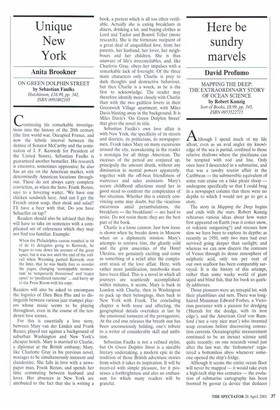Unique New York
Anita Brookner
ON GREEN DOLPHIN STREET by Sebastian Faulks
Hutchinson, £16.99, pp. 341, ISBN 0091802105
Continuing his remarkable investigations into the history of the 20th century (the first world war, Occupied France, and now the febrile interval between the demise of Senator McCarthy and the nomination of J. F. Kennedy for President of the United States), Sebastian Faulks is guaranteed another bestseller. His research is extensive, sometimes oppressive; he also has an eye on the American market, with determinedly American locutions throughout. These do not always carry complete conviction, as when the hero, Frank Renzo, says to a hovering waiter, 'We have one chicken sandwich here. And can I get the French onion soup, then steak and salad? I'll have a beer with that. Do you have Schaeffer on tap?'
Readers should also be advised that they will have to take on sentences with a complicated set of references which they may not find too familiar. Example:
When the Philadelphia caucus resulted in 64 of its 81 delegates going to Kennedy, he began to tone down his account of the great upset, but it was not until the end of the rollcall when Wyoming pushed Kennedy over the limit, that he was finally free to reorder the pages, changing 'unstoppable momentum to 'temporarily threatened' and 'major upset' to 'predicted outcome' ... and hurry up to the Press Room with his copy.
Readers will also be asked to encompass the logistics of Dien Bien Phu and to distinguish between various jazz trumpet players whose music seems to be playing throughout, even in the course of the tenderest love scenes.
For this is essentially a love story, between Mary van der Linden and Frank Renzo, played out against a background of suburban Washington and New York's cheaper hotels. Mary is married to Charlie, a diplomat at the British embassy; Mary, like Charlotte Gray in his previous novel, manages to be simultaneously innocent and clandestine. She falls in love with a newspaper man, Frank Renzo, and spends her time commuting between husband and lover. Her absences in New York are attributed to the fact that she is writing a book, a pretext which is all too often verifiable. Actually she is eating breakfasts in diners, drinking a lot, and buying clothes at Lord and Taylor and Bonwit Teller (more research). She is the fortunate recipient of a great deal of unqualified love, from her parents, her husband, her lover, her neighbours and her children. She is thus unaware of life's irreconcilables, and. like Charlotte Gray, obeys her impulses with a remarkable lack of foresight. Of the three main characters only Charlie is prey to dark thoughts and destructive behaviour, but then Charlie is a wreck, as he is the first to acknowledge. The reader may therefore identify more closely with Charlie than with the two guiltless lovers in their Greenwich Village apartment, with Miles Davis blasting away in the background. It is Miles Davis's 'On Green Dolphin Street' that gives the novel its title.
Sebastian Faulks's own love affair is with New York, the specificity of its streets and districts, its politicians, its newspapermen. Frank takes Mary on many excursions around the city, reawakening in the reader a nostalgia for all things American. The excesses of the period are conjured up, principally the amount drunk, without any diminution in mental powers apparently, together with the off-beat friendliness of waitresses and sales assistants. Mary's secure childhood affections stand her in good stead to confront the complexities of her situation. Whether this is entirely convincing some may doubt, but the vicarious excursions amid perambulations, the breakfasts — the breakfasts! — are hard to resist. Do not resist them; they are the best part of the book.
Charlie is a loose cannon. Just how loose is shown when he breaks down in Moscow when on a diplomatic mission. Mary's attempts to retrieve him, the ghastly cold and the grim amenities of the Hotel Ukraina, are genuinely exciting and come as something of a relief after the complacent stasis of the love affair. Here, with rather more justification, notebooks must have been filled. This is a novel in which all journeys are seamlessly accomplished: within minutes, it seems, Mary is back in London with Charlie, then in Washington to pack up their belongings, then back in New York with Frank. The concluding chapter is both tense and affecting, the geographical details overtaken at last by the emotional torments of the protagonists. At the end one releases the breath one has been unconsciously holding, one's tribute to a writer of considerable skill and ambition.
Sebastian Faulks is not a refined stylist, but On Green Dolphin Street is a sizeable literary undertaking, a modern epic in the tradition of those British adventure stories from which it takes its inspiration. It will be received with simple pleasure, for it possesses a forthrightness and also an enthusiasm for which many readers will be grateful.


































































 Previous page
Previous page